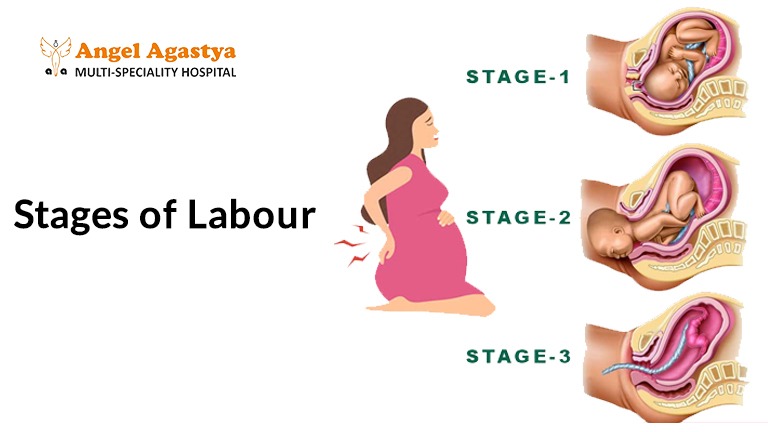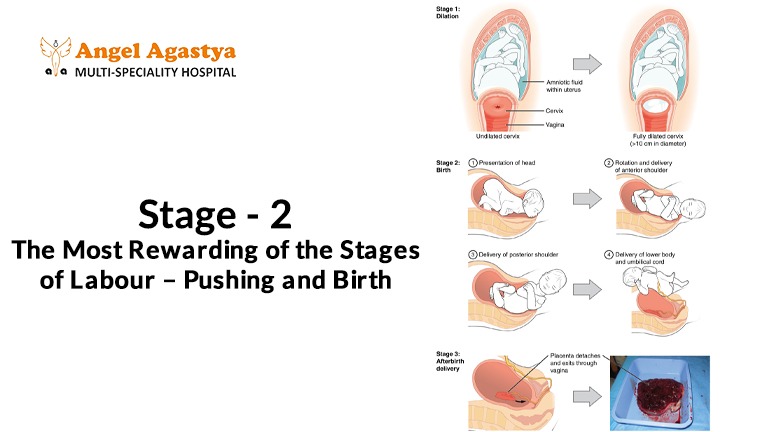Stages of Labour: 3 Powerful Journey Your Body Takes to Bring Life Into the World
Wondering what happens during childbirth? Discover the three decisive stages of labour and how your body works like magic to bring your baby into the world. For expecting parents, the phrase “Stages of Labour” often brings a mix of anticipation and questions like “When will it start? How will I know?” While we might first think of labour as just pain or water breaking, it’s truly a beautiful and complex process with much more happening inside. Always consult and update your gynaecologist if you feel uncomfortable.

Introduction
The stages of labour are a wonderfully coordinated sequence where your body’s muscles, hormones, and nature’s wisdom work together to welcome your baby into the world. Generally, there are three main stages of labour:
Stage 1: Cervical Dilation – This is the longest stage, where the cervix gradually opens to allow the baby to pass through. It’s like a flower slowly blooming.
Stage 2: Pushing and Birth – Once the cervix is fully open, it’s time to actively push and bring your baby into your arms. This is where your strength and determination truly shine.
Stage 3: Placental Delivery – After your baby is born, the uterus continues to contract to deliver the placenta, also known as the afterbirth. This final stage completes the birthing process.
Understanding these stages of labour isn’t just medical knowledge; it’s empowering for you and your family. Knowing what’s happening inside can help you feel calmer, more in control, and build trust in your body’s incredible ability. So, let’s embrace the magic of the stages of labour, one step at a time, as you prepare for the arrival of your little one.
Stage 1: The Longest of All Stages of Labour – Cervical Changes
The first stage of labour, often the longest, is like the initial chapters of a grand story, where your cervix gently prepares to open and welcome your baby. Think of it like the slow unfolding of a lotus flower. This stage is beautifully divided into three phases: Early Labour, Active Labour, and Transition.
1. Early Labour
This marks the very beginning of the stages of labour, a gentle unfolding much like the first notes of a beautiful raga.

- Effacement: Your cervix starts to thin and soften, much like a tightly woven silk fabric becoming more supple. Imagine a closed bud slowly beginning to open its petals.
- Dilation: The cervix gradually opens from 0 to about 3–4 cm. This can take several hours, sometimes even a day or two, especially for first-time mothers – like waiting for the first monsoon showers to truly soak the earth.
- Contractions: You’ll feel mild, irregular cramps, similar to the discomfort of your monthly period. These are like gentle waves lapping at the shore, preparing for the stronger tides to come.
- Hormonal Action: Hormones called prostaglandins play a vital role, softening the cervix and gently nudging the stages of labour forward, like a mother’s soothing touch.
2. Active Labour
This phase signifies a more intense part of the stages of labour, where progress picks up pace, like the rhythm of a vibrant folk dance.
- Faster Dilation: Your cervix dilates more quickly, from 4 to 7 cm like a river gaining momentum as it flows towards the sea.
- Stronger Contractions: Contractions become more frequent, occurring every 3–5 minutes and lasting up to a minute. They are like stronger beats of a drum, guiding the birthing process.
- Baby Moves Down: Your baby begins to descend further into your pelvis, preparing for the final journey, much like a precious jewel being carefully lowered.
- Oxytocin: The hormone oxytocin plays a crucial role, strengthening and regularizing your contractions, it’s like the conductor of an orchestra, ensuring a harmonious progression through this stage of the stages of labour.
3. Transition Phase
This is often the most intense part of Stage 1 of the stages of labour, a powerful crescendo before the final act, yet it’s usually the shortest phase, like the final, dramatic notes of a powerful song.
- Full Dilation: Your cervix reaches a full 10 cm the gateway is now fully open to welcome your baby.
- Strong Contractions: You’ll experience intense waves of contractions lasting 60–90 seconds with very little rest in between, like powerful surges of energy guiding your baby downwards.
- Emotional Peak: You might feel overwhelmed or even doubt yourself, but remember, this intense feeling is a sign that you are incredibly close to meeting your baby, like reaching the peak of a mountain just before beholding a breathtaking view.
- Final Descent: Your baby moves into the optimal position for birth, ready for the final push into the world.
This initial stage of the stages of labour is a remarkable preparation, akin to setting the stage for the most awaited performance, the arrival of your child. It’s a testament to your body’s strength and the beautiful journey of motherhood.
Stage 2: The Most Rewarding of the Stages of Labour – Pushing and Birth
Once your cervix is completely open, like the gates of a grand temple welcoming its devotees, the second stage of the stages of labour begins that is the time for active pushing, the final effort to bring your precious baby into your arms.

Full Cervical Dilation
This is the clear signal that the path is ready, and your baby can now journey through the birth canal, like a little boat ready to sail into the vast ocean.
The Urge to Push
This isn’t just a feeling; it’s a natural, powerful urge, much like the body’s instinct to breathe. it happens when your baby’s head gently presses on nerves in your pelvis, telling you it’s time to push.
Coordinated Pushing
Your uterus continues its rhythmic, involuntary contractions, like the steady beat of a drum. With the support of your caregivers, you’ll also actively push using your stomach and pelvic muscles, working in harmony with your body’s natural rhythm.
Baby’s Journey Through the Birth Canal
Your baby embarks on a remarkable journey through the birth canal, involving a series of intricate movements, an essential part of this stage in the stages of labour:
- Engagement: The baby’s head enters your pelvis, like a key fitting into a lock.
- Descent: The baby moves further down, inching closer to the outside world.
- Flexion: The baby tucks its chin towards its chest, making its head the smallest it can be.
- Internal Rotation: The baby’s head turns to navigate the curves of your pelvis.
- Extension: The baby’s head extends as it passes under your pubic bone.
- External Rotation: The baby’s head turns again to align with its shoulders.
- Expulsion: With your powerful pushes, your baby’s body is finally born.
Crowning
This is a magical moment when the top of your baby’s head becomes visible at the opening of your vagina. You might feel a stretching sensation, sometimes called the “ring of fire.”
Birth
With one final surge of effort, or perhaps a few more, your baby makes their grand entrance into the world. This stage of the stages of labour is often the most emotionally overwhelming and deeply satisfying, the culmination of months of anticipation.
Hormonal Magic
A beautiful rush of hormones, especially oxytocin (the love hormone) and endorphins (natural pain relievers), floods your body. This promotes instant bonding with your newborn and provides a sense of euphoria. Indeed, the stages of labour are beautifully orchestrated by these powerful natural messengers.
Stage 3: The Final of the Stages of Labour – Placental Delivery
Even after your precious baby has arrived in your arms, the final stages of labour are still to come – the delivery of the placenta, the baby’s companion during pregnancy.

Uterine Contractions Continue
Your uterus, which has worked so hard, continues to contract gently now, like a mother tenderly releasing her hold.
Placental Separation
As your uterus becomes smaller, the placenta, which is attached to its wall, begins to detach, much like a leaf gently falling from a tree. This usually takes about 5 to 30 minutes.
Signs It’s Time
Your healthcare providers will look for certain signs indicating the placenta is ready to be delivered: a sudden gush of blood, the umbilical cord appearing longer outside, and your uterus feeling firmer and sitting higher in your abdomen. These are like nature’s signals that the final part of the stages of labour is near.
Expelling the Placenta
With a gentle push from you or sometimes even naturally, the placenta will slide out. It might feel like passing a large blood clot.
Preventing Bleeding
After the placenta is delivered, your uterus clamps down firmly on the blood vessels where the placenta was attached. This is incredibly important to prevent excessive bleeding, making this stage just as vital as the earlier stages of labour for your well-being.
Hormonal Balance Continues
The wonderful hormone oxytocin continues its work, encouraging these final contractions and strengthening the beautiful bond between you and your baby. With the completion of all stages of labour, your body now begins its journey of recovery, like the gentle settling after a joyous celebration.
Hormones in Action Throughout the Stages of Labour
The stages of labour aren’t just physical—they’re deeply hormonal. Here’s how your body works behind the scenes:
- Oxytocin: Stimulates contractions, supports pushing, triggers bonding.
- Prostaglandins: Soften the cervix and may start labour.
- Endorphins: Natural painkillers that rise as labour intensifies.
- Adrenaline: Provides energy for pushing but can delay labour if stress is high.
- Relaxin: Softens joints and ligaments for easier passage of the baby.
A calm, supported environment helps these hormones work harmoniously during all stages of labour.
Conclusion
The stages of labour represent one of the most profound physiological events a woman can experience. Each stage has its purpose:
- Stage 1: Cervix softens and opens.
- Stage 2: Baby travels through the birth canal.
- Stage 3: Placenta is delivered and recovery begins.
All stages of labour are guided by natural hormones ensuring safety, comfort, and bonding. When you understand what happens during the stages of labour, it builds confidence and removes fear.
You’re not just enduring labour but you’re participating in one of life’s greatest miracles. While the stages of labour show how strong and capable your body is, it’s essential to consult a gynaecologist if you experience any discomfort or signs that feel unusual than your safety and your baby’s wellbeing come first.
FAQs: Understanding the Stages of Labour
- How long does each stage of labour last?
- Stage 1: 6–20 hours
- Stage 2: 20 minutes to 2 hours
- Stage 3: 5–30 minutes
- Why do contractions differ in each stage of labour?
They increase in strength and frequency as each stage progresses. - What happens to the baby during each stage of labour?
The baby moves lower, rotates, and aligns for birth. - What’s the role of amniotic fluid in the stages of labour?
Cushions the baby, aids dilation, and lubricates the birth canal. - Why is the cervix so important in Stage 1 of labour?
It must fully open to allow the baby to pass through. - What causes the urge to push in Stage 2 of labour?
The Ferguson reflex, triggered by the baby’s head pressing on nerves. - Why do contractions continue after birth?
To help expel the placenta and reduce bleeding. - How does the body transition between stages of labour?
Hormonal feedback and physical signals drive progression. - Are the stages of labour the same for every woman?
No, they vary greatly in duration and intensity. - Do pain medications affect the stages of labour?
Yes, they may slow contractions or change how pushing feels.

